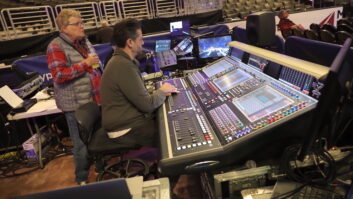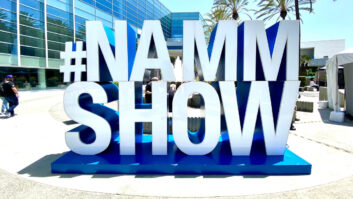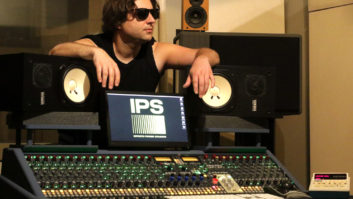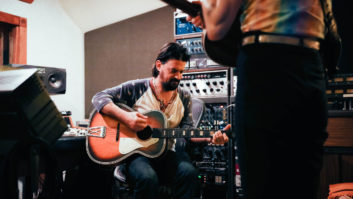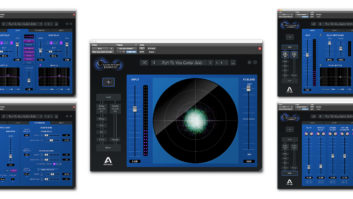This Machine Is ObsoleteOnly a handful of contemporary musicians have left as indelible a footprint on popular music as Trent Reznor – the sole creative force behind Nine Inch Nails. Emerging out of the Cleveland industrial scene in the early ’90s, NIN’s fusion of metal and new wave stylings, pop sensibilities and Reznor’s edgy persona quickly secured the band a devoted, if not religious, following. Though NIN’s first two studio albums went Platinum, Reznor didn’t really become a household name until ’94; in that year, the band released The Downward Spiral (which debuted at Number 2), scored the most unlikely of hits with the single “Closer” and shook the moral majority to its core with their mud-covered Woodstock performance. Within a blink of an eye, Reznor went on to essentially legitimize the use of computers in music production, again popularized synthesizers and electronic music (paving the way for countless imitators) and managed to hand Marilyn Manson a career.
Last year, following a five-year hiatus and two years in the studio, Reznor let loose The Fragile, which by most accounts, is his finest work to date. Long before the weighty two-CD set even made it to store shelves, Reznor and the extended NIN family, which includes Charlie Clouser (keyboards/vocals), Danny Lohner (guitar/bass/keyboards/vocals), Robin Finck (guitar/vocals) and Jerome Dillon (drums), were already hard at work preparing for the Fragility tour – an ambitious undertaking that has taken the band through Europe, Japan, Australia, New Zealand, the U.S. and back to Europe for the summer festival season.
Mix caught up with the band for two of its California dates last June at the Cow Palace in San Francisco and at the then recently opened Sacramento Valley Amphitheater. The two- hour-plus set included generous amounts of material from all four of the band’s studio albums. Some of the older tracks like “Terrible Lie” and “Sin” had been revamped and rethought with the addition of some dynamic breaks, Dillon’s contribution on drums, and a live theremin, manipulated by Clouser. But at least half of the always shifting set comprised new material from The Fragile, ranging from more subtle and atmospheric tracks like “The Day the World Went Away” and “The Great Below” to the scorching guitars and electro-nic grind of “The Wretched” and “Starf superscript ***ers Inc.”
UNDERNEATH IT ALLTo prepare for the tour, the band had to first decide which of the songs on The Fragile would lend themselves to being played live. Second, they had to decide exactly how they were going to carry it off. Much of the pre-tour preparation involved going back into the original Pro Tools sessions and stripping the songs back to their essential elements, combining sounds, creating sample banks and outfitting both Clouser’s keyboard rig and Dillon’s hybrid electronic/acoustic drum kit – a task that Reznor, Clouser, keyboard tech Bruce Hendrix and backline tech Jon Danny were left to tackle. “Trent is very private about the material he generates on the record, and he trusts Charlie to dismantle it into samples that might be used,” Danny explains. “After Charlie had taken everything out of the Pro Tools sessions with Trent’s help, we then put Bruce on the task of normalizing everything or L1-ing everything in Peak and Waves.”
Not eager to repeat the follies of tours past, Reznor adopted a “simpler is better” philosophy – the entire synth and sample library is just under 100 MB. Keyboard controllers aside, the synth rig consists of two Emulator 4 Ultras, which, according to Hendrix, is actually making for a more consistent-sounding show. “We don’t have a whole studio worth of gear out on the road that sounds different every night. The sounds are dead-on,” he notes. Similarly stripped down, the percussion banks are stored on a single 8MB PMCIA card on an Alesis DM Pro drum module. “The triggers run straight into the DM Pro, straight into its brain, straight to the card, no MIDI, no hard drives, no loading, no SCSI, nothing,” explains Danny. “Trigger inputs go straight into the machine that holds the samples. That little credit card-size card holds all of the drum sounds for the show plus more that we never get around to using.”
Following weeks of preparation and band rehearsals, veteran live sound engineer Jon Lemon was brought in to take the helm as FOH. Lemon’s FOH credits include stints with such seminal alt-rock acts as The Cure, Smashing Pumpkins, Depeche Mode and Live. “In talking to Trent,” Lemon says, “I got the impression that realistically, it wasn’t just `take the album and let’s try and reproduce it’ because it probably couldn’t have happened. That album is such a masterpiece of layering, between him and Alan Moulder. So, they sort of stripped it out to have the main elements as well then adding in Jerome Dillon, having a real drummer in there. It’s different from the album, but it’s the same on another level. All of the key elements are there.
“For me [the process] was fairly logical, like most things are in this camp,” Lemon continues. “They clearly thought about the space and how it would end up sounding, mixing-wise. Obviously, when we got into the situation when the mixing board was up, things changed slightly at that point. They were very thoughtful musically about how much space there should be for all the songs. For me, it was reasonably easy. I mean, there were a lot of things because of again having a real drum kit vs. a lot of electronic sounds. At that point, we had to start combining samples and real drums and triggers. That probably took longer than anything else, to get that balance down. The last time they were out, it was a lot more in-your-face, incredibly loud. Whereas now it sort of reflects more of what’s going on with the album. There is a lot more fidelity and space, and you sort of hear everything that’s happening. It’s a different time for Nine Inch Nails.”
IT RUNS EVEN DEEPERDue to the constantly changing instrumentation of the songs, several of the bandmembers are jumping between instruments. Reznor, in addition to lead vocals, switches between guitar, bass and two sets of keys; Lohner jumps between guitar, bass and keys; and Clouser’s swiveling, multi-arm synth rig houses a keyboard controller, a vocoder and a theremin. “That’s the style of automation that an XL-4 really helps with,” Lemon explains “It’s always auto-muting stuff. You always know where you’re going in your next MIDI switch. The board then controls all the MIDI for the effects and the stuff like that. From that standpoint, that’s really the extent of the automation. I can also switch the MIDI from the computer in case they decide to go to something different.”
Lemon is using all 56 available inputs on his Midas XL-4 console, 40 mono and eight stereo. Working from left to right, a large group of faders is dedicated to acoustic and electronic percussion, plus a stereo pair for a Tascam DA-88, which provides some of the unplayable atmospheres and textures but no other backing tracks. “And then everybody comes up in their banks because everyone is using multiple instruments,” says Lemon. “For example, with Danny we have bass, stereo keys and stereo guitar and so on, and then vocals and effects returns.
“Most of the effects, I think, are fairly standard. Especially when you are dealing in a digital world, I like warmth and valves and stuff like that,” Lemon continues. His outboard racks include Distressors and BSS EQ on the two main vocal chains (Reznor and Finck), Smart compressors on Reznor’s and Lohner’s keys and DA-88, Summit DCL-200s on Clouser’s keys, dbx 160As on guitars, TLA 100 on bass guitar, and TC 5000 and Focusrite EQ on acoustic drums. For some of the classic, industrial-sounding vocal distortion, Lemon uses a “Depth Charger” bass-guitar stomp box, which sits on top of his effects rack. “We love lo-fi as well as high-fi,” Lemon says with a chuckle. “Because this is actually designed for a bass guitar, it tends to let through a wider bandwidth. You’re not just concentrating on that small high-midrange guitar distortion, and it works really well. I use it on `Star superscript ***kers’ and `Suck.’ Each one is little different. One is more of a radio/tube sounding thing, and I do that more with the EQ.”
All four of the vocal mics are Shure SM58s. The acoustic drums are miked with an SM7 on kick, SM57 on snare top, AKG 414 on snare bottom, SM81 on hi-hat, SM98s on toms and a pair of AKG 414 overheads. There is also a Logitech passive switcher that sits at the monitor board for Reznor’s mic. This enables the crew to instantly switch mic feeds and hand Reznor a fresh mic. The band’s onstage behavior is less-than-easy on the equipment, and Reznor has been know to go through a number of mics in a single evening.
The main P.A. is a Britannia Row Turbo Sound Flashlight system with Floodlight components down front for the pit. “I think I’ve mixed more shows on a Flashlight than anyone else on the planet,” says Lemon. “It’s kind of being updated at the moment – we’ve got newer, longer throw boxes on the top. It’s their first time out, and it’s something I’ve wanted them to build for a number of years now. They’ve got the same components, but they’re EQ’d totally different from the normal mids and highs. Again, that’s just for the longer throw. And they’ve been dubbed the `Lemon Box’ with a little `Lemon’ logo on back, which amused me intensely. The system now consists of the main Flashlight system with the Lemons, which are flown with the Floodlights on the sides, and the underhung cabinets are there just to get the people down front.”
OVERCOME THE COMPLICATIONSStage volume and audience feedback have always been integral aspects of NIN’s live performance. Unfortunately, due to the subtle nature of much of the material on this tour, standard wedges alone simply wouldn’t suffice. Songs like “The Great Below” and “La Mer” require some or all of the bandmembers to switch over to in-ears. Handling monitors was Brent Carpenter. “They’re all using [in-ears] at different times,” he explains. “They all use them on `The Great Below,’ but then they use them on different songs. Danny uses his on four songs, Robin uses his on three, Trent uses his for three, and of course, it depends on what the set is that night.”
Carpenter is mixing on a Yamaha PM4000M. The wedges and sidefills are all Clair Bros. models; in-ears are all custom molds by Future Sonics. As on any tour, each member of the band requires his own custom monitor mix, and Carpenter had his hands full keeping everyone happy. “Trent’s mixes are based purely on how loud I can get his vocal,” says Carpenter. “He’s got a little bit of everything in there – kick, snare and hat for timing, synth bass and the actual bass guitar to get his pitch. The only time I use any reverb is on `Hurt,’ which is the last song, where I just put a drum reverb in to make it more dramatic.”
In addition to a complicated monitor setup, Carpenter also has to contend with the almost constant onstage combat and flying debris. “Microphones do have a tendency to fall into horns,” he notes. “I ride that vocal all night. But he gets hit and when he gets hit, he gets hit hard because it’s a pretty loud stage. I try and do what I can to prevent it, but sometimes gravity is faster than my finger. [Laughs.]
“They tend to be very intense onstage. Robin has been to the hospital four times – he keeps getting hit in the head with his own guitar. Young Jerome, our drummer, got hit in the head with a 58 thrown from downstage center. Just your typical Nine Inch Nails beating the hell out of each other.”
